Gritsch Mauritiushof
by
Terry Sullivan
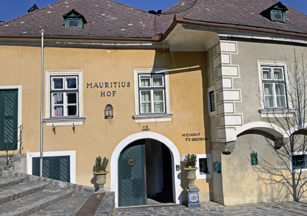 Summary: The Gritsch Mauritiushof Winery tasting room is located in a centuries old house just a few steps from the gothic Catholic Church St. Mauritius. During the late 1400s monks used the building for winemaking. The Gritsch family acquired the property at the end of the 18th century. The winery is family owned and run with several family members involved in the day-to-day operations from the vineyards to the winery.
Summary: The Gritsch Mauritiushof Winery tasting room is located in a centuries old house just a few steps from the gothic Catholic Church St. Mauritius. During the late 1400s monks used the building for winemaking. The Gritsch family acquired the property at the end of the 18th century. The winery is family owned and run with several family members involved in the day-to-day operations from the vineyards to the winery.
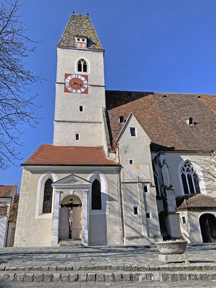 Our Austrian tour guide, Agnes Horvath, drove into Spitz, where we arrived at a piazza and parked near the church St.Mauritius. After parking, we walked across the piazza to a yellow colored building that had the words Mauritius Hof in large letters. Over the entrance, in smaller letters, were the words Weingut F.J. Gritsch. Entering the residence, we met Martha Nothnagl who grew up in this house where her brother Franz-Josef Gritsch, the winemaker, and his family now live. A new winery facility is located nearby.
Our Austrian tour guide, Agnes Horvath, drove into Spitz, where we arrived at a piazza and parked near the church St.Mauritius. After parking, we walked across the piazza to a yellow colored building that had the words Mauritius Hof in large letters. Over the entrance, in smaller letters, were the words Weingut F.J. Gritsch. Entering the residence, we met Martha Nothnagl who grew up in this house where her brother Franz-Josef Gritsch, the winemaker, and his family now live. A new winery facility is located nearby.
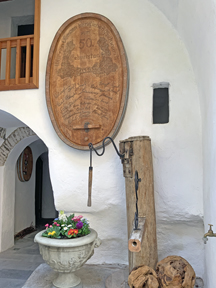 An inner courtyard is in the center of the building. From this courtyard we observed a decorative wood carving on a head of a cask. The cask head is now hanging on a wall. Along the arches on a higher floor, dried corn was hanging from a poll across the arch giving the appearance that this is a home. After talking with us about the winery and its history, Martha ushered us to the tasting room and retail area.
An inner courtyard is in the center of the building. From this courtyard we observed a decorative wood carving on a head of a cask. The cask head is now hanging on a wall. Along the arches on a higher floor, dried corn was hanging from a poll across the arch giving the appearance that this is a home. After talking with us about the winery and its history, Martha ushered us to the tasting room and retail area.
We learned that Gritsch Mauritiushof is a multi-generational family-run winery. The house was built at the end of the 13th century. Originally, the monks used the building for winemaking. The Gritsch family bought the property in 1799. The current winemaker is the seventh generation to make wine in this house.
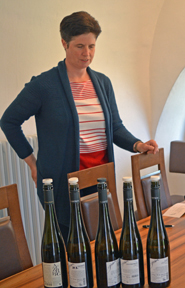 Martha, who is an “expert in the vineyards,” mentioned that Gritsch Mauritiushof has 15 hectares (37 acres) of vineyards. Along the terraces there are plantings of Grüner Veltliner, Riesling, Muskateller, Sauvignon Blanc and Neuburger. These 15 hectares of vines are divided among 11 vineyard sites. The basic soil of the area is granite and clay, although each vineyard site varies. Because of the terraces, only manual labor is used in the vineyards.
Martha, who is an “expert in the vineyards,” mentioned that Gritsch Mauritiushof has 15 hectares (37 acres) of vineyards. Along the terraces there are plantings of Grüner Veltliner, Riesling, Muskateller, Sauvignon Blanc and Neuburger. These 15 hectares of vines are divided among 11 vineyard sites. The basic soil of the area is granite and clay, although each vineyard site varies. Because of the terraces, only manual labor is used in the vineyards.
Martha proceeded to tell us about the family. Since her brother Franz-Josef Gritsch was the only son, he had to continue the family winemaking career. He attended a wine school in Krems and learned about winemaking from his father and grandfather. Martha’s parents are still involved in the winery. Her father, Franz Gritsch, is also a vineyard expert and spends time in the vineyards. Martha’s mother, Leopoldine Gritsch, is the “good soul of the winery.” Martha’s sister-in-law Maria Theresia Gritsch works in the office.
Throughout our wine tasting we learned of the importance tradition has in crafting the wines. The family lives with wine everyday and they work with nature. Winery production is 100,000 bottles.
Wines
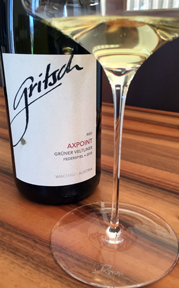 Our first wine was a 2018 Grüner Veltliner Federspiel, Axpoint Vineyard. The wine had a yellow color with 12.5% alcohol. Citrus and yellow stone fruit were noticed on the aroma. The taste had a silky mouthfeel and offered peach, apricot and mineral. The fruity finish yielded to mineral.
Our first wine was a 2018 Grüner Veltliner Federspiel, Axpoint Vineyard. The wine had a yellow color with 12.5% alcohol. Citrus and yellow stone fruit were noticed on the aroma. The taste had a silky mouthfeel and offered peach, apricot and mineral. The fruity finish yielded to mineral.
Our next wine was similar, but from a different vineyard. The 2018 Grüner Veltliner Federspiel, Klaus Vineyard was also a yellow color with 12.5% alcohol. The yellow stone fruit with a citrus aroma had peaches, apricots and grapefruit on the taste. The wine had a silky mouthfeel. The finish integrated fruit with mineral.
The 2018 Riesling Federspiel, 1000-Eimerberg Vineyard was a yellow color with 12.5% alcohol. This Riesling had flowers and citrus on the aroma. The taste had a silky mouthfeel and was reminiscent of honeysuckle and white roses. The finish had floral notes that yielded to mineral.
We tried a Smaragd. The 2017 Grüner Veltliner Smaragd, Atzberg Vineyard had a dark yellow color and 14% alcohol. Mineral and yellow stone fruit were noticed on the aroma. The taste had a velvety mouthfeel with apricots and mineral. The fruity finish yielded to mineral on the aftertaste.
The 2018 Muskateller Federspiel, Hartberg Vineyard was a light yellow color with 12.5% alcohol. Orange blossoms predominated the aroma and taste. The mouthfeel was velvety and also had lemon notes. The finish of orange blossoms and lemons yielded to mineral on the aftertaste.
According to Martha, the winery “has a tradition of making good wine. Not many wineries are in old traditional houses.” Wine enthusiasts visiting Spitz should make an appointment at Gritsch Mauritiushof. This winery offers the experience of tasting several vineyard specific wines.
Gritsch Mauritiushof
Kirchenplatz 13, 3620 Spitz, Austria
Article written April 2019.
